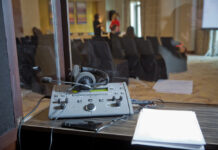The construction industry is undergoing a gradual yet significant transformation as it integrates digital technologies. This shift creates new opportunities for professionals who can blend technological expertise with an understanding of industry-specific challenges.
Historically, the construction sector has been slow to adopt new technologies. However, the increasing involvement of IT professionals is changing this landscape. These experts apply their skills to automate processes, enhance efficiency, and implement innovative solutions within the traditionally conservative construction field.
To better understand how web development experience can serve as the foundation for building a successful business in the construction industry, we spoke to an experienced software developer, Roman Belov.
Roman Belov is a technology innovator and co-founder of HandyDay — a digital platform recognized for significantly modernizing project management in the traditionally non-digital construction sector. By bridging advanced IT systems with construction workflows, Mr. Roman Belov has introduced scalable, replicable solutions that reduce inefficiencies across the industry. With a background in web development and a master’s degree earned in 2004, he has worked in tech roles across Russia, Sweden, and Spain. Since 2020, he has led HandyDay’s technical development, building the system from scratch, assembling a remote IT team, and scaling the platform to serve a growing client base. Under his leadership, the company secured funding from Sweden’s innovation agency and private investors. Mr. Roman Belov has also participated in international startup programs, including Antler Stockholm, and won a pitch at a Málaga-based incubator. He is also the author of several peer-reviewed scientific articles, published in respected scholarly journals, including APNI (2023), Universum: Technical Sciences (2025), and Vestnik Nauki (2025). His research encompasses topics such as client-server architecture, DevOps methodologies, and performance optimization in distributed systems.
Roman, could you tell us about your professional journey? You successfully adapted IT skills to the construction sector, but how did a person with a background in web development end up in construction?
I began my career as a web developer, which provided a solid foundation for working with technology. Web development is all about solving problems from scratch, and this experience taught me not to fear challenges but to look for ways to overcome them. The key moment was moving to Sweden in 2012, where I immersed myself in the dynamic startup ecosystem. There, I began to understand how my technical skills could be applied to traditional industries, such as construction.
From the backend infrastructure to the web-based applications, you combine strong leadership with technical skills. How have your technical skills — especially your experience in structuring digital systems — helped you solve real-world inefficiencies in construction, and could this approach be applied in large-scale markets like Germany, the U.S., or South Korea, where infrastructure modernization is a national priority?
IT taught me how to structure processes and operate in conditions of uncertainty. Web development is always about finding the optimal path, and I brought this mindset to business. For example, I actively use Agile principles in product development and company management. The ability to quickly test hypotheses, collect feedback, and iterate is a critical skill for any modern business.
Roman, you played a critical role in bringing HandyDay to life by building the entire technical foundation, especially after earlier failed development attempts. The project quickly gained traction after you stepped in and adapted to the client’s and industry’s needs. What made your contribution irreplaceable in the success of HandyDay, and how do you think your skill set compares to what’s typically available in major innovation hubs like Silicon Valley, Berlin, or Stockholm?
At the very start of the project, I talked with one of the co-founders, who shared that earlier attempts to launch the product with a development agency had not succeeded. From the beginning, it was clear that success would require more than just technical programming skills. What made the difference was the ability to listen carefully, adapt to the client’s real needs, and understand the specifics of the construction industry.
My role was to bridge the gap between the founders’ vision and actual execution, translating that vision into a working solution that addressed core issues. I was responsible for everything from the backend systems to the web-based interface, ensuring that the technical foundation and user experience were aligned with real-world workflows. Drawing on my previous experience with a wide range of clients, I focused on solving practical problems that had previously been overlooked. That’s ultimately what ensured the product was successfully delivered.
Over the past 5 years, your platform has significantly improved construction project management by reducing coordination time by nearly a third and substantially decreasing documentation errors compared to previous competitors’ attempts. What insights from your IT background were key to achieving measurable results like reduced coordination time and error rates, and do you believe these same insights could improve construction workflows in countries where modernization is now a top priority, such as the U.S., the U.K., and Canada?
My experience in IT taught me how to structure processes and build user interactions. HandyDay started with my idea that construction companies need simple and effective tools for project management. We started small, with an MVP that allowed us to get feedback from clients quickly. This iterative approach helped us adapt the product to real industry needs and make it in demand.
When I joined the project, the co-founder expressed frustration with previous failed attempts to bring the idea to life. It was clear that success required more than technical skills — it needed someone who could listen, adapt, and deeply understand the client’s goals and challenges. My role involved bridging the gap between the vision and execution, adapting to their industry, and solving previously overlooked problems. My ability to empathize with the client and my experience working with various clients were crucial in ensuring the product finally saw the light of day. This approach — focusing on the client’s needs, solving their core problems, and delivering a functional solution — made the difference.
You were also part of the Mivida project, where you prepared and delivered the winning pitch that earned first place in the Demium AllStartup competition—an international award that recognizes exceptional startups for the best pitch. How did that experience influence your approach to solving challenges in the construction industry?
Participating in programs like Antler Stockholm and Demium was crucial to my understanding of how to build viable solutions for traditional industries. The experience taught me how to pitch projects, secure funding, and create effective teams. Most importantly, it showed me how to adapt technological solutions to meet real-world industry needs.
Your company has received a significant grant of 900,000 SEK from the Swedish Innovation Agency, Vinnova, for developing a digital ecosystem in the construction industry — a remarkable milestone, especially considering the startup was still at the very early stage at the time of application. Can you highlight specific innovations you’ve developed that could be relevant for streamlining construction management, not just locally, but in global markets, where infrastructure projects often suffer from delays and inefficiencies?
My approach always starts with a deep understanding of the problem. I spent months talking to builders and observing their work, focusing on the internal processes and how the construction industry operates within office settings. Only after that did we start development following the Minimum Viable Product (MVP) approach. This allowed us to quickly test hypotheses and adapt the solution to meet the real needs of users.
As someone implementing digital solutions in construction, in your experience, what are the core barriers to tech adoption in construction, and are these challenges similar across markets like Spain, the U.S., and Germany, where traditional practices often slow down innovation?
Construction is an entirely different ecosystem with its own rules and traditions. Initially, it was challenging to understand the specifics of the industry because it differs significantly from the IT sector. However, my development experience helped me adapt quickly. I studied builders’ needs, daily tasks, and challenges in great detail. This allowed me to speak their language and create solutions that genuinely work.
With major construction companies increasing their tech investments, given the rising investment in tech by major construction firms, how do you see the global industry evolving, and where does your work fit into that transformation?
We are at an exciting stage. On the one hand, construction remains one of the least digitalized industries. On the other hand, technologies are emerging right now that can radically change the situation. Artificial intelligence, big data, and the Internet of Things are all emerging technologies that are finding applications in construction. Specialists capable of adapting these technologies to industry specifics are critically important.
What advice would you give to technology companies looking to enter the construction sector?
Don’t be afraid to step out of your comfort zone. Construction is a vast, complex industry that offers opportunities for those willing to learn and adapt. The key is to understand that technology is a tool that must solve real problems. Start with a deep dive into the industry, find a mentor from the construction field, and be ready to learn a lot. And remember: your technical skills are a huge advantage, but success will only come when you learn to apply them to solve real-world problems in the construction industry.
How do you see your role evolving at the intersection of technology and construction — and do you plan to expand your work into innovation ecosystems such as the U.S., Western Europe, or East Asia, particularly where construction digitalization has become a policy and economic focus?
I see my role as a bridge between technology and the construction industry. I plan to continue developing my competencies in both fields because it’s at their intersection that the most interesting solutions are born. I also want to dedicate more time to mentoring—helping other IT professionals find their way in the construction industry. I am convinced that the future lies in an interdisciplinary approach, and I want to be part of these changes.
Find a Home-Based Business to Start-Up >>> Hundreds of Business Listings.















































